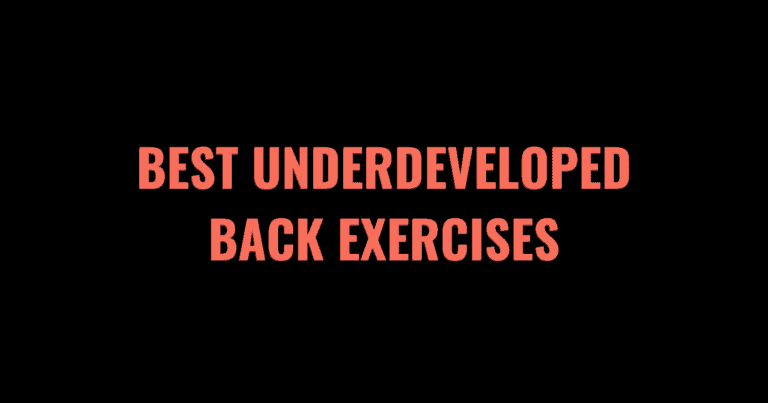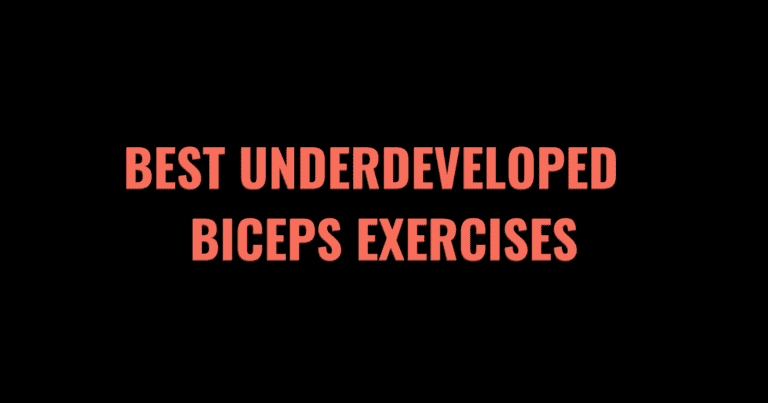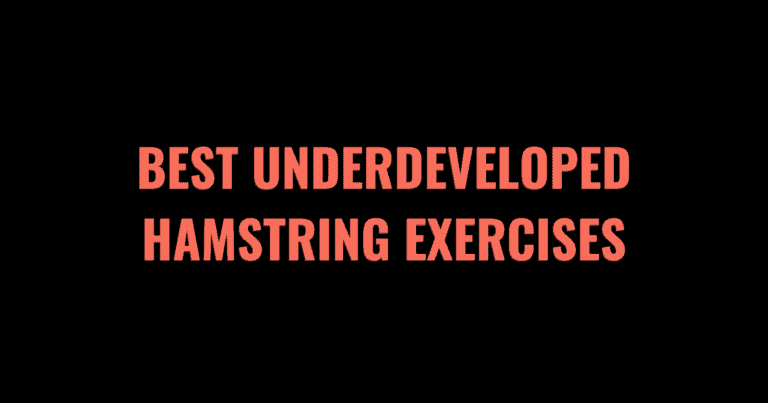Have you noticed that your upper chest doesn’t stand out like the rest of your upper body? It’s quite common to have an upper chest that’s smaller and/or weaker than the front, lower chest, triceps, side delts, and biceps.
If your upper chest is lagging and are looking for ways to fix it, you’ve come to the right place! We’ve compiled a list of the best ways to grow and strengthen an underdeveloped upper chest. You’ll also learn the optimal rep ranges, exercises, intensities, and training volume to kickstart upper chest hypertrophy.
Keep reading to learn more and start growing!
Table of Contents
- 1 What is an Underdeveloped Upper Chest?
- 2 The 8 Best Ways to Grow a Bigger Upper Chest
- 2.1 Increase your weekly training volume
- 2.2 Increase your weekly training frequency
- 2.3 Make sure you train with enough exercise intensity
- 2.4 Improve your exercise technique
- 2.5 Switch up your exercise order and selection
- 2.6 Change your exercise tempo
- 2.7 Perform each exercise with full range of motion
- 2.8 Modify your rep range periodically
- 3 The 10 best exercises for a bigger upper chest
- 4 Upper Chest Muscle Anatomy
- 5 Upper Chest FAQs
- 6 Conclusion
- 7 Grow Underdeveloped Muscle Groups
- 7.1 The 7 Best Ways to Grow Bigger Rear Delts
- 7.2 The 8 Best Ways to Grow a Bigger Back
- 7.3 The 8 Best Ways to Grow Bigger Upper Abs
- 7.4 The 8 Best Ways to Strengthen Abs
- 7.5 The 8 Best Ways to Grow Bigger Biceps
- 7.6 The 8 Best Ways to Grow Bigger Traps
- 7.7 The 8 Best Ways to Build an Underdeveloped Core
- 7.8 The 8 Best Ways to Grow a Bigger Lower Chest
- 7.9 The 8 Best Ways to Grow Bigger Front Delts
- 7.10 The 5 Best Ways to Grow Bigger Triceps
- 7.11 The 8 Best Ways to Grow Bigger Hamstrings
- 7.12 The 8 Best Ways to Grow Bigger Shoulders
- 7.13 The 7 Best Ways to Grow Underdeveloped Obliques
What is an Underdeveloped Upper Chest?
An underdeveloped upper chest occurs when the clavicular head of the pectoralis major is smaller and/or weaker than the other upper body muscles. The best way to improve a weaker upper chest is by performing more incline pushing and isolation chest exercises.
Other effective training techniques for growing your upper chest include increasing your weekly upper chest training volume, intensity, and frequency. However, it’s also important to consider exercise selection, order, technique, range of motion, rep range, and tempo.
This article will cover the most worthwhile tactics you can utilize to get your upper chest to grow!
Related: How to Grow a Bigger Lower Chest
The 8 Best Ways to Grow a Bigger Upper Chest
- Increase your weekly upper chest training volume
- Increase your weekly upper chest training frequency
- Make sure you train with enough exercise intensity
- Improve your exercise technique
- Switch up your exercise order and selection
- Change your exercise tempo
- Perform each exercise with full range of motion
- Modify your rep range periodically
Here are the 8 best ways to grow an underdeveloped upper chest:
Increase your weekly training volume
Weekly training volume is one of the first things you should assess when attempting to grow your upper chest. Weekly training volume is primarily determined by the number of hard sets you perform for a specific body part. Remember that warm-up sets are not included when calculating how many sets you perform for the upper chest.
According to Renaissance Periodization’s training volume landmarks for hypertrophy, you should perform at least 10 direct weekly sets to stimulate upper chest growth. With that said, 12-20 sets per week suits most people.
Dr. Mike Israetel, a world-renowned professor and bodybuilder, recommends starting with the minimum amount of volume that’s effective for growth (also known as minimum effective volume) (MEV)), which in this case, would be 10 sets. From there, add sets each week as needed to continue seeing progress until you reach a point where you cannot recover (known as the maximum recoverable volume (MRV)).
How can you tell if you reached the point of MRV?
Here are some signs:
- You are no longer getting a good pump in the target muscle.
- You’re getting weaker or have hit a plateau in terms of strength.
- You have nagging aches and pains in the muscle or surrounding joints.
- You cannot recover from session to session.
Everyone’s maximum recoverable volume is different. Once you reach that point, deload and start the cycle over again.
It’s important to note that the amount of effective training volume you can do depends on how many days per week you train that muscle. If you only work the chest once a week, evidence suggests that doing more than 8-10 sets in a single session isn’t beneficial. If you have to do more sets than that to grow, train the muscle more frequently, which is what we cover next!
Increase your weekly training frequency
If you’re only hitting your chest once per week, one of the best things you can do to grow is to start training your upper chest 2 to 3 times per week. You can increase your training volume, perform a wider variety of exercises, and improve recovery by training your upper chest more often. Not to mention, you will be stimulating muscle protein synthesis more often, which is key for hypertrophy.
If you normally do incline bench press, cable flys, and dumbbell bench press on Monday, try doing the incline bench press and cable flys on Monday and the dumbbell bench press and incline smith machine press on Thursday or Friday. If you perform 3 sets of each exercise, your weekly training volume for the upper chest will be at 12 sets, and it gives you room to increase as needed.
It’s not uncommon for someone to train a weaker body part up to 3 times per week. According to Renaissance Periodization’s training volume landmarks for hypertrophy, it’s ideal to train your chest 1.5-3x per week. It’s important not to train your chest every day because it needs time to recover, adapt, and grow.
If you train your chest more often and with a higher volume, monitor your training intensity closely to ensure you’re not overdoing it.
Make sure you train with enough exercise intensity
It’s possible to train with enough volume and frequency but fail to see progress because you aren’t training with enough intensity. Intensity is determined by how close you train to failure, and it is often calculated using an RPE (rate of perceived exertion) or RIR (reps in reserve) scale.
It’s important to note that powerlifters and other strength athletes also use percentage-based training to determine, but that’s not as useful for hypertrophy.
Although some preach that you have to train to failure and beyond for muscle growth, that couldn’t be further from the truth. In fact, you can effectively train up to 1-3 reps shy of failure! That said, it takes experience to gauge how far you are from failure.
It’s quite common for new lifters to stop 4 or even 5 reps shy from failure, which isn’t ideal for hypertrophy. You won’t see much muscle gain if you are not pushing yourself hard enough. So, you should occasionally train to fail to test yourself every time. Failure is defined as not being able to perform another rep with proper technique.
Lastly, some exercises lend themselves to failure training better than others. For example, it’s safer to train to failure on a cable chest fly than on an incline barbell bench press. Don’t just train harder; train smarter as well.
Improve your exercise technique
Having proper exercise technique is crucial for upper chest hypertrophy as well as staying injury free. If you are performing movement and don’t feel your upper chest activating, you’re likely doing something wrong. If you have a lagging body part, it’s very likely that your technique could be drastically improved.
To improve your exercise form, lower the weight, slow down the tempo, and focus on the mind-muscle connection. In other words, you need to leave your ego at the door. Form improvements are especially important for the upper chest because the front delts often take over the movement when fatigue sets in.
Keep your lats activated when performing any chest exercise so that your shoulders are set down and back. Not only does this tactic give you access to a greater range of motion, but it ensures that your chest is doing the work and reduces the risk of a shoulder injury. Lastly, consider bringing your elbows together rather than your hands during any chest fly variation. This cue will improve your ability to contract the chest.
Switch up your exercise order and selection
For any lagging body part, performing the exercise that targets the muscle at the beginning of the training session is extremely beneficial. If performing an upper body workout, schedule an exercise that engages the upper chest first, such as the incline dumbbell bench press or incline chest fly. Since you are fresh at the beginning of the workout, you will be stronger and readily able to overload the muscle.
In terms of exercise selection, it’s very common for people to claim that some movements are superior to others. However, everyone is different, so it’s a good idea to experiment with different upper chest exercises to see which one you like the most.
Not to mention, if you’ve been performing a certain exercise, like the barbell bench press, for an extended period of time, switching to a slightly different variation may be just what you need to spark muscle growth. Performing various incline chest presses and flys for the upper chest is recommended because that’s what activates that portion of the chest the most. Regardless of what exercises you choose, make sure you are doing them with proper form!
Change your exercise tempo
Beyond changing your exercise selection, you can challenge a muscle by modifying the exercise tempo. Exercise tempo, also known as time under tension, is usually prescribed using a 3 or 4-digit code, such as 3-1-2-0.
Here’s what a 3-1-2-0 exercise tempo would look like while performing a dumbbell chest press:
- It should take you 3 seconds to lower the dumbbells to your chest.
- Hold the dumbbells at your chest for 1 second.
- It should take you 2 seconds to lift the dumbbells from your chest until your arms are fully extended.
- Don’t pause at the top. Immediately begin the next rep.
The most important number to consider when assessing exercise tempo is the first number which represents the lift’s eccentric (lowering) portion. Controlling the eccentric creates the most muscle damage, leading to repair and growth.
During the exercise’s concentric (lifting) portion, focus on moving the weight as explosively as possible. You know you are fatigued when the concentric portion slows down dramatically.
Perform each exercise with full range of motion
This tactic goes hand-in-hand with proper exercise form. Even if you have proper form, you can still fail to use a full range of motion. Typically, exercises that enable you to get a larger range of motion result in more muscle growth.
That’s why many bodybuilders prefer the dumbbell bench press over the barbell bench press. Performing half reps or quarter reps may be beneficial in some circumstances. Still, most of your reps should be performed with a full range of motion.
Normally, people who do not use a full range of motion do so because they are lifting too heavy (ego-lifting) or have poor mobility. Before going up in weight, perfect your exercise form and ensure you are doing the movement with a full range of motion. See a personal trainer or physical therapist to address the issue if you have poor mobility.
Modify your rep range periodically
Similar to occasionally switching up your exercise selection, it’s a good idea to modify your rep ranges. For example, if you’ve been performing 4-6 reps for 4 weeks, do 12-15 reps for the next 4 weeks.
Changing your rep range will activate different muscle fiber types, leading to more hypertrophy. Within every muscle group, you have fast twitch (type II) and slow twitch (type I) muscle fibers. Fast twitch muscle fibers respond best to a lower rep range and heavier weights.
On the other hand, slow twitch muscle fibers respond better to a higher rep range and lighter weights. To stimulate hypertrophy across all muscle fiber types, use various rep ranges and train 1-3 reps shy from failure.
The 10 best exercises for a bigger upper chest
Here are the 10 best exercises you can do to build a bigger and stronger upper chest:
- Incline Barbell Bench Press
- Incline Dumbbell Bench Press
- Incline Smith Machine Press
- Incline Hammer Strength Machine Press
- Incline Dumbbell Fly
- Low-to-High Cable Fly
- Flat Bench Press
- Flat Dumbbell Bench Press
- Pec Deck (Machine Fly)
- Push-Ups
If you want to learn how to perform some of these exercises correctly, check out this article: The 8 Best Incline Bench Press Alternatives.
Upper Chest Muscle Anatomy
The chest muscle, also known as the pectoralis major, is located on the front of the upper body. The chest muscle is a rather large muscle group, so it’s divided into two parts – the clavicular head (upper chest muscle) and the sternocostal head (middle/lower chest muscle).
Both portions of the chest contribute to horizontal adduction of the humerus (upper arm). The middle and lower portions activate more during a flat bench press, whereas the upper portion is more active during an incline bench press. Since the upper chest attaches to the clavicle, it also assists with shoulder flexion. Although you cannot completely isolate the upper chest, incline bench exercises emphasize it more.
As mentioned earlier, it’s common for the front delt, a muscle located on the front of the shoulder, to take over the exercise. Ensure your shoulder blades are pulled down and back to reduce the front delt involvement.
Upper Chest FAQs
How often should you train your upper chest?
You should be training your upper chest muscles at least once per week. If your upper chest is weaker, you may want to consider training 2-3 times per week. Your training frequency should ultimately be determined by your schedule and ability to recover. Pick a training split that’s sustainable and realistic.
At what intensity should your upper chest be trained?
Like other muscle groups, you should train your upper chest muscles 1-3 reps shy from failure. It’s fine to train to failure every once in a while, but you do not have to train to failure to grow. If you’re setting up a training mesocycle, start out by stopping the set 3 reps from failure, then decrease that as the weeks progress.
Here’s what that would look like:
- Week 1 – Train 3 reps from failure
- Week 2 – Train 2 reps from failure
- Week 3 – Train 1 rep from failure
- Week 4 – Train to failure
- Week 5 – Deload
What’s the best rep range to grow your upper chest?
Unlike strength training, hypertrophy can be achieved using a variety of rep ranges, from 5 reps all the way to 30 reps. Regardless of the rep range, training intensity is the most important.
Ensure you’re not stopping the set more than 4 reps from failure. The most popular rep range for hypertrophy is 8-12 reps, but you should occasionally do 6-8 reps and 15-20 reps to provide a different stimulus.
What type of exercises train the upper chest?
The main actions of the upper chest muscles include shoulder flexion, horizontal adduction, and internal rotation. Although the upper chest is involved during all pushing and chest isolation movements, it’s most active when the exercise is performed on a slight incline.
Some popular upper chest exercises include:
- Incline dumbbell chest fly
- Low to high cable fly
- Flat bench press
- Incline bench press
- Incline dumbbell bench press
- Incline machine chest press
- Machine chest press
Conclusion
It’s very common to have undeveloped upper chest muscles and overdeveloped front delts. To get the upper chest to grow and get stronger, you must train it with enough frequency, intensity, and volume. You also need to pick the right exercises, perform them with proper form, and use a full range of motion.
Switching up your exercises, tempo, and rep ranges is okay, but don’t employ these tactics as often. Give your body enough time to adapt to the training stimulus you’re providing before deciding to do something different. Beyond training, eating enough calories and protein daily is crucial for muscle growth. Make sure you fuel your body to perform, recover, and grow!
Grow Underdeveloped Muscle Groups
If you enjoyed this post, check out our other guides on how to grow lagging muscle groups.












